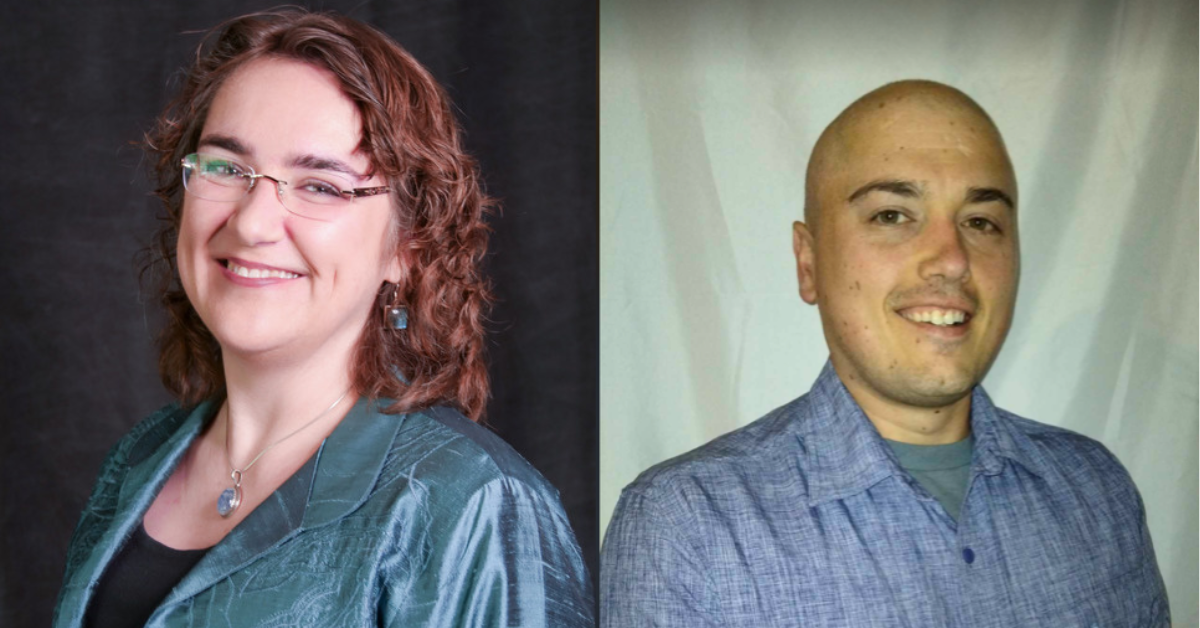Lisa M. Parcell is the Betty and Oliver Elliott Distinguished Professor of Communication and Graduate Coordinator for the Elliott School of Communication at Wichita State University. Her main research area is the area of media history advertising and public relations, particularly the promotion of American food products between 1880-1960.
Paul Myers is a research manager in the Elliott School of Communication at Wichita State University. His main research area is the intersection of advertising and its interaction with cultures, particularly early 1900s food advertising and its capitalization or facilitation of societal trends.
Q: How did you become aware of the important role of the test kitchen in advertising history?
Myers: As we peruse through advertisements, we keep seeing this focus on women in lab coats, very well put together. Then [we wonder] why does this exist? Why is this such a recurring theme across brands and throughout quite a long period of years? We’ve done research into home economics previously, and we see the push for home economics to be a type of science. So that’s kind of like the springboard.
Parcell: Yeah, we knew that there were women in advertising agencies eventually, and we had heard that there were a few that had a domestic science or home economics background. So, in other words, had an education, a college education that was a science-based education. But we didn’t know that it was a strategy. And I think that was the most interesting thing to us, that brands recognized that they needed to reach women, but they couldn’t use just anybody off the street. They purposely went out to find college-educated women who had a degree, who could speak the language and were trustworthy. And that essentially made them part of the advertising team. I don’t think [these companies] intended to make them part of the advertising team, knowing what was going on at the time, but they did. Then slowly advertising agencies hired domestic science or home economics experts, and it just grew from there.
Q: It was a kind of ‘foot in the door?’
Parcell: Yeah! You look back and you think, ‘duh,’ but you hadn’t actually thought through how it happened. And I think that was the most fascinating part for Paul and me. We knew the home economics movement was huge, and we knew it was important. We knew that it was trying to tap into a need that women had of understanding their role and being able to cook and being able to provide for their kids and to get the most value out of their dollar and their time. But we didn’t realize that it was a very calculated strategy on the part of brands to meet that need.
Q: For the newly working women, was the transition from home economics to working in advertising comparable to any other field at the time?
Parcell: I would say it’s somewhat similar to the female journalists who were hired to write the women’s pages. They kept them in what they would call the hen coop, and they were very much second-class citizens and were left to just do the ‘frivolous’ and ‘unimportant’ stuff, the cooking and the society pages and the clothes, that kind of thing. And then eventually, they leaned on them more and more to do harder news stories.
Myers: I do think that there are parallels with women journalists, and again, I think it was purely coincidental. It was an experimentation at first to see how home economics could be used since it was this growing, huge social movement that was gaining recognition enough for these women to have some say in the political sphere on very micro issues, large scale micro issues. And it was like, ‘Okay, we’ll use the science you’re producing, but oh, what if we have you also deliver the message?’ And then it was, ‘Oh, we’re actually selling products to women. Women are who are spending the money, so we should have women advertising to women.’ Just like in the journalism field, there were women writing what were called ‘women’s stories’ for women. So, there are definitely parallels.
Q: How do you think the fight for food purity and truthful advertising led to an increase in media and consumer literacy?
Parcell: On that topic? Absolutely. The idea of food purity and adulteration and all that goes way back to the 1800s. So, the common lore is that Upton Sinclair’s book, The Jungle, was what tipped it over, and that was like the beyond. It wasn’t, it was really just a tipping point. It wasn’t the introduction. It had been going on for decades, and because women were seeing more and more products out there, it’s understandable that they were then concerned that food purity was an increasing problem. And you have to dovetail that with false advertising. So, there was a lot of snake oil being sold out there. For most advertisers, they did not like it, because it made people not trust legitimate products, and people who did the shopping didn’t know what to believe.
Myers: The primary issue was the lack of literacy of the consumer. And home economics, though it was a social movement, finds its origin as an educational movement. They wanted to educate the housewife on how to safely and properly take care of their family to the best of their ability with the limited resources they have. So, a dollar wasted is a dollar taken away from the family. And wherever home economists start entering into advertising, you saw a real, legitimate shift away from, ‘We’re just telling you the greatness of the product,’ to, ‘We are trying to educate you on the best way to use this product, how to identify a good product.’ Just the overall economy of the product is probably the best way to view it.
Parcell: To dovetail to what Paul said, I don’t think home economists would see themselves as reformers as much as educators. It was very much an education movement. ‘We’re going to teach consumers how to get the most value for their money and time.’ So, they weren’t going after food adulterers or false advertising or any of the rest of that. They were really trying to educate and help women make better decisions and make better use of their time.
Q: How has the history of the test kitchen and demographic-centric advertising influenced the modern advertising approach?
Parcell: We still advertise to women. If you think about most of the products that you see, women are still considered the shoppers, and so most products are advertised to women. Even if you go to the grocery store, you see a mix of everybody. And test kitchens are still very much a part of many companies, they just don’t necessarily advertise it as such. They still print recipes, they still test out new products, they still try to find new ways to use those products. I was at General Mills last spring, and while I was there in the archives, the test kitchens were trying out new recipes for cinnamon rolls, so they brought me a cinnamon roll. So, they’re still very much alive. [Test kitchens] just ended up with a bad reputation because of the feminist movement and women wanting to be seen as more than just tied to the kitchen. So, it’s now part of the research and development part of the product rather than the advertising face of the product.
Q: What was your writing process like as a team? How did you operate as co-authors?
Myers: OK. So, I guess the good news is Lisa and I know each other very well in terms of where our individual interests are and how our interests meet. We also have a good idea of how each other works. So basically, we came together from our last paper, we saw that there was something here. So, I work on the home economic side, looking into it, seeing what I can find from the background of the education sphere, and Lisa is a marketing, branding guru. So, she has all that knowledge to put in on the front face. Then it’s just melding these two worlds together, trying to line up literature to see where it meets. From there, it just falls into place naturally. I don’t know if you have a different way to describe it.
Parcell: No, I think that’s perfect. I really enjoy working with a co-author. A lot of people prefer writing by themselves. I prefer writing with a co-author. I like the process of bouncing ideas off of each other. I like finding somebody that has strengths in one area that I can complement with the strengths in my area and working that balance to make a better end product. And Paul and I have different strengths and different interests, like you said, and it really works. It also helps hold you accountable. If you tell somebody else that you’re going to have the thing done on Tuesday, you really don’t want to go back and go, ‘Well…’ So, it helps move the process along where otherwise you might put something on a back burner.
Q: Did you have anything to add about your current research?
Parcell: Yeah! So, at the end of that paper, we mentioned that food brands were interested in using radio as a way to advertise and to continue sharing recipes and giving advice and teaching women how to use the products. And that’s going to be the focus of the paper that we are working on at the moment. Looking at how food brands used radio with all the experimentation, hiccups, limitations, you know, everything that was part of trying to figure out how radio and advertising were going to work together, how these food brands used that time period to experiment and figure out what would work to get their message across in this whole new media. And it’s fascinating, because brands didn’t really have a plan from the beginning like you would with the print campaign, because we’ve been doing print for so long. Brands were really figuring it out as radio developed, which is what makes it a heck of a lot of fun.
Myers: And then, one other aspect to that is the government influence or relationship with everything, because the government, just like with TV, was hoping that it would be a tool for education. And well, we see where it is now. The government ended up producing a lot of home economic style literature, which was produced by home economists who were on one side educational and on the other side advertising. So, there’s an interesting dynamic there. The research involving home economics is huge. In my lifetime, I will never be able to tackle all of the advertising, education, and communication related aspects of it. Home economists documented everything. It’s all archived. If somebody doesn’t know what to research next, it’s out there. You just have to find out what little, tiny piece of this huge mountain of literature you want to look at!

